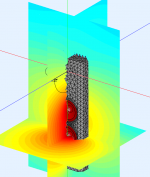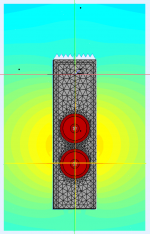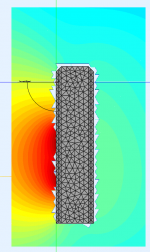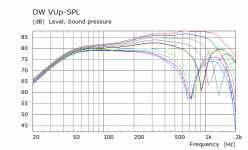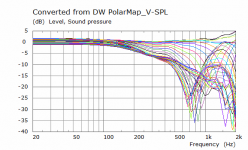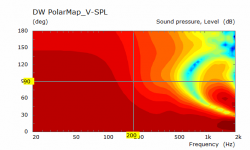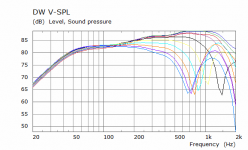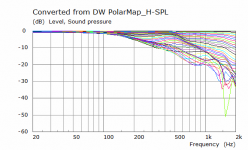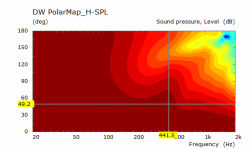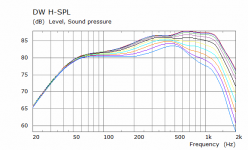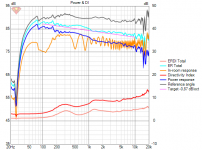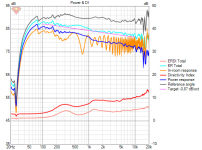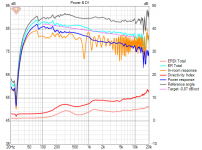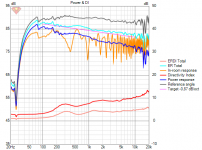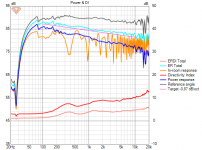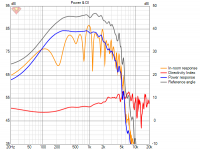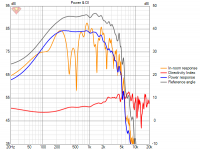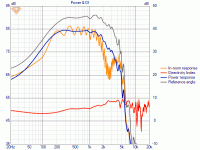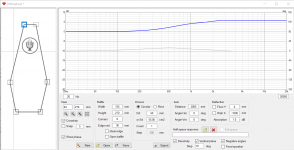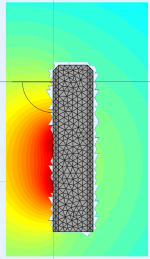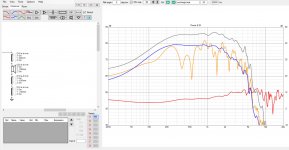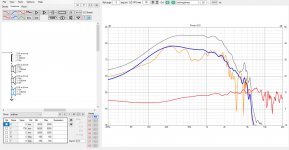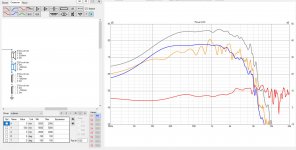The 'big corner loaded ones'! 😀
But if you feel some others you've done are more interesting for this thread it is ok for me.
Maybe explain what are your priority in the design approach?
But if you feel some others you've done are more interesting for this thread it is ok for me.
Maybe explain what are your priority in the design approach?
I hope Allen finds the time and inclination to answer krivium's questions.
In the mean time I have some results for the mid driver, I've stuck with the flat disc for this one. Trying to simulate the dome tweeter and augerpro waveguide failed again in the same way it did before, seems to be related to 1/4 vs 1/2 symmetry which doesn't make much sense to me right now. I think the small finite baffle will have to serve as a close enough simulation of the tweeter and waveguide.
There is Horizontal and Vertical up and down as shown in this depiction of the simulation points.
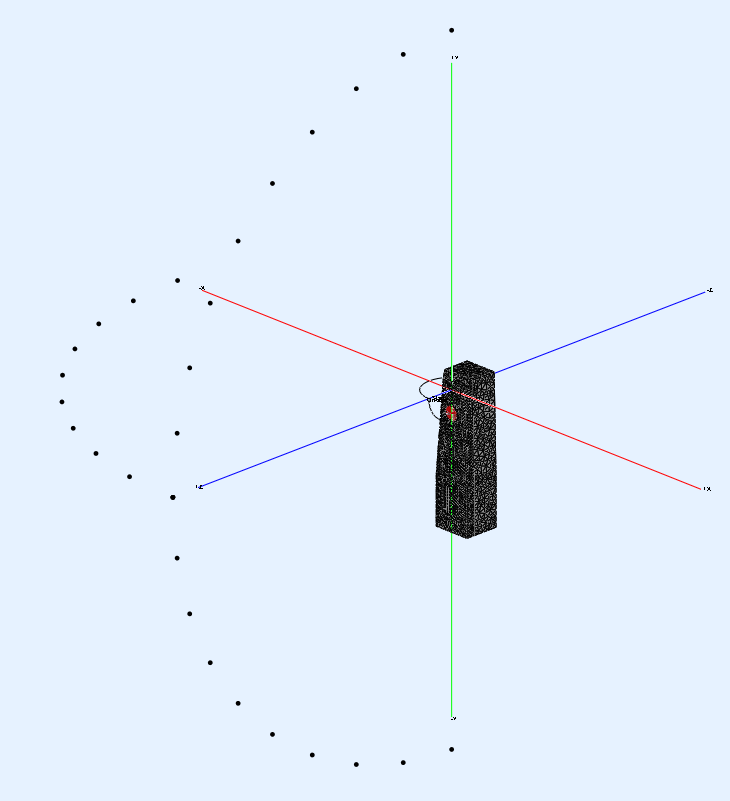
In the mean time I have some results for the mid driver, I've stuck with the flat disc for this one. Trying to simulate the dome tweeter and augerpro waveguide failed again in the same way it did before, seems to be related to 1/4 vs 1/2 symmetry which doesn't make much sense to me right now. I think the small finite baffle will have to serve as a close enough simulation of the tweeter and waveguide.
There is Horizontal and Vertical up and down as shown in this depiction of the simulation points.
Attachments
-
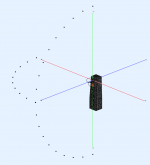 SPL Sampling Points.png42.7 KB · Views: 781
SPL Sampling Points.png42.7 KB · Views: 781 -
 M V Up SPL.png13.7 KB · Views: 116
M V Up SPL.png13.7 KB · Views: 116 -
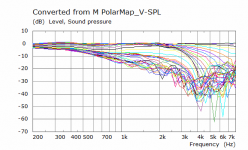 M V Polar Curves.png22.4 KB · Views: 110
M V Polar Curves.png22.4 KB · Views: 110 -
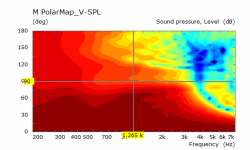 M V Polar.png41.8 KB · Views: 109
M V Polar.png41.8 KB · Views: 109 -
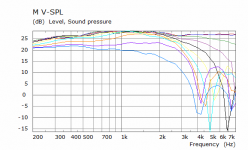 M V SPL.png13.2 KB · Views: 110
M V SPL.png13.2 KB · Views: 110 -
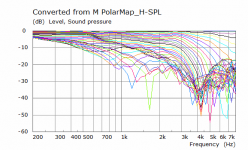 M H Polar Curves.png25.3 KB · Views: 199
M H Polar Curves.png25.3 KB · Views: 199 -
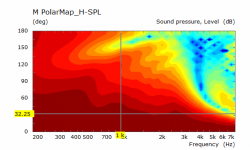 M H Polar.png40.1 KB · Views: 205
M H Polar.png40.1 KB · Views: 205 -
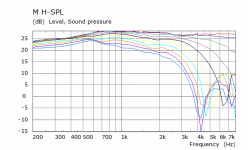 M H SPL.png13.2 KB · Views: 196
M H SPL.png13.2 KB · Views: 196
Seems like you are getting closer and closer to the Avalon speaker in post #1
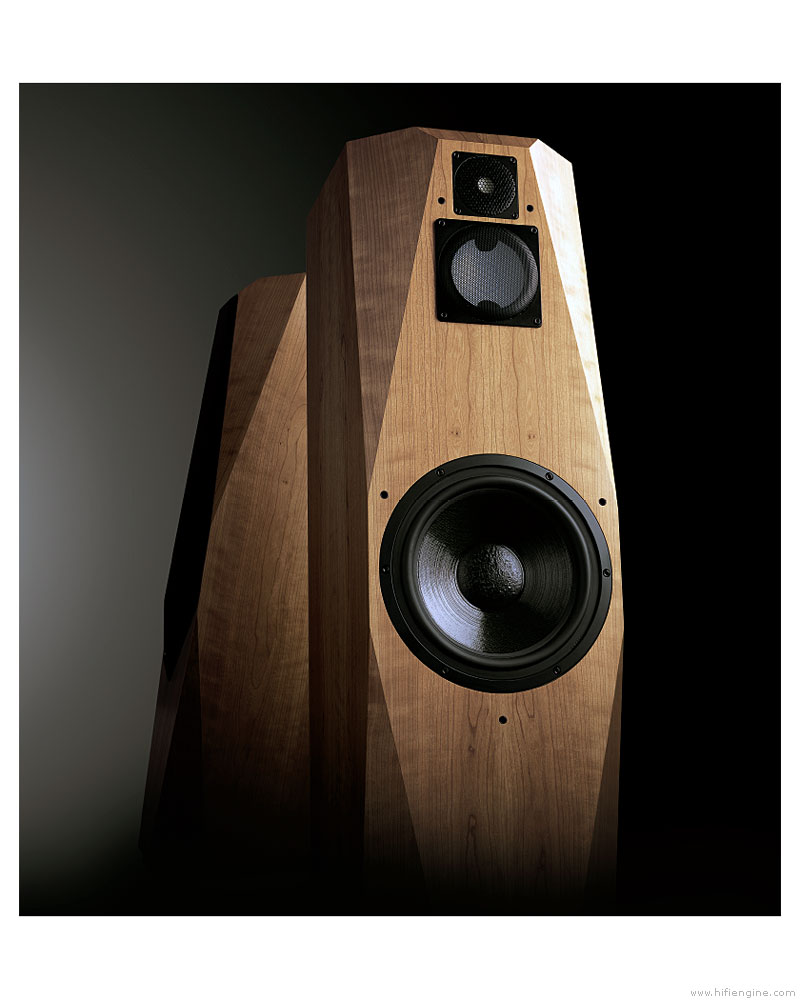
Which was expected. Using waveguide for the tweeter modifies directivity above 1kHz, which is also audible. Preference of sound with/wo wg is just personal preference, not quantifiable or absolute.
If you don't have an opinion or ready-made preference about it, how about making protos and listening? Same apples to making the bass BR or closed box. A bit of challenge is that a pair is needed to realize what different directivity means for stereo listening...
Which was expected. Using waveguide for the tweeter modifies directivity above 1kHz, which is also audible. Preference of sound with/wo wg is just personal preference, not quantifiable or absolute.
If you don't have an opinion or ready-made preference about it, how about making protos and listening? Same apples to making the bass BR or closed box. A bit of challenge is that a pair is needed to realize what different directivity means for stereo listening...
Good advice from Juhazi.
To round out the simulations I have included a dual woofer setup to show what effect that has. You see the spread vertically and the difference in the shape of the wavefront when looking from the front. 300Hz this time.
To round out the simulations I have included a dual woofer setup to show what effect that has. You see the spread vertically and the difference in the shape of the wavefront when looking from the front. 300Hz this time.
Attachments
SPL and Polar Maps, all you have to do is buy two more WO24's 🙂
Attachments
Seems like you are getting closer and closer to the Avalon speaker in post #1
Which was expected. Using waveguide for the tweeter modifies directivity above 1kHz, which is also audible. Preference of sound with/wo wg is just personal preference, not quantifiable or absolute.
If you don't have an opinion or ready-made preference about it, how about making protos and listening? Same apples to making the bass BR or closed box. A bit of challenge is that a pair is needed to realize what different directivity means for stereo listening...
Thanks Juhazi for the suggestion. I liked the avalon looks. Now I like the rockport more.. 😀
I already listened to the waveguided tweeter+mid combination on a prototype foam box using a crossover designed with limited measurements. Even then, I couldn't find out any issue with the waveguided tweeter. I don't know how to describe sound quality well. With the kind of songs I listen to, the only thing I could make out to some extent at least is overall it was smooth, even when I turned up the volume. I didn't feel like I should turn it down (which happens sometimes when I turn up the volume on my current speakers). But I agree that there could be a lot of variables to optimize here. I will try. Regarding BR vs sealed, I really have to get a proper box made for the woofer, which is hard currently in the place I live. Again, I will try. 🙂
SPL and Polar Maps, all you have to do is buy two more WO24's 🙂
Hi fluid, thanks for these sims, could you explain a bit more about the advantage with two drivers. I understand that it will put less pressure on a single driver and I will be able to reach higher SPLs. But doesn't it increase the box volume requirements significantly? Do I wire the two drivers in parallel or series? How is a resulting 'good' box alignment determined? Would I need two more amp channels/outputs from DSP?
The other thing is these bass drivers are currently out of stock at the official dealer in my country. The only drivers that seem to be available now anywhere near this category here is SB34NRXL75-8 12 inch drivers. The dealers says WO24P is not going to come back in stock anytime soon. And usually, it costs really a lot here. I had to save up quite some money even to buy the current drivers I have.. 😀
It may take a few more months If I am going to buy more drivers, but I will try.. 🙂
Last edited:
Two woofers needs twice the internal volume to end up with the same alignment. There is a fair bit of space in the cabinet being a tall floorstander so I doubt it would be a big issue. Worst case scenario is that you have to use more EQ to lift the low end, but now you have twice as much volume displacement.Hi fluid, thanks for these sims, could you explain a bit more about the advantage with two drivers. I understand that it will put less pressure on a single driver and I will be able to reach higher SPLs. But doesn't it increase the box volume requirements significantly? Do I wire the two drivers in parallel or series? How is a resulting 'good' box alignment determined? Would I need two more amp channels/outputs from DSP?
Parallel is better if possible (one driver cannot modulate the other) but that would depend on the impedance of the woofers you have. Parallel will halve the impedance, series will double it. Paralleling two 4 ohm drivers will put a lot of strain on the amplifier and test it's current capability. You can still run it off one amp and DSP channel.
The benefits would be smoother room interaction in the bass region, greater volume displacement, less movement of each driver to deliver the same SPL, downside is cost and availability for you.
Two woofers needs twice the internal volume to end up with the same alignment. There is a fair bit of space in the cabinet being a tall floorstander so I doubt it would be a big issue. Worst case scenario is that you have to use more EQ to lift the low end, but now you have twice as much volume displacement.
Parallel is better if possible (one driver cannot modulate the other) but that would depend on the impedance of the woofers you have. Parallel will halve the impedance, series will double it. Paralleling two 4 ohm drivers will put a lot of strain on the amplifier and test it's current capability. You can still run it off one amp and DSP channel.
The benefits would be smoother room interaction in the bass region, greater volume displacement, less movement of each driver to deliver the same SPL, downside is cost and availability for you.
Thanks fluid. 🙂
Hopefully, I will try to do something regarding this in the coming months.
^^ Wouldn't reducing the room interaction require bigger spacing of sources to be effective in bass region? The drivers act as one below ~200Hz if within ~40cm from each other, in other words they appear as one in terms of room interaction. Higher in frequency they will have narrower vertical dispersion compared to one woofer though which could be advantageous though. I assume here the bass region means where the room dominates, long wavelengths.
Made some tests with VCAD few days ago to check out if it was better to put the woofer closer to floor on a 3-way speaker or not. VCAD has ability to show some effect of floor and ceiling reflections. Woofer at floor boundary is fine but the difference was not too big, kind of expected with the long wavelengths. However higher up in the low mids I was able to manipulate driver locations so that the floor and ceiling reflections average out instead of magnifying each other. Nicest response was with some low mid narrowing on vertical directivity by woofer / mid spacing AND especially vertical position of the mid in relation to the room height.
Another observation was that even 5cm change in the mid position would reintroduce some of the ripple back in so I'm not sure if this is an effective way to address room interaction, at least not alone, and should be done with RTA I think and not by sims. Reasoning from this experiment I'd say there is not much point optimize woofer position (or amount, unless very many) in attempt to minimize room interaction unless the room is taken into consideration and the speaker built (or adjusted) into that particular environment.
For this reason I'd rank woofer (vertical) interaction with room very much a secondary (not important) design goal on a three way speaker, unless also the mid (and tweeter) was designed and positioned with the vertical room interaction in mind. And, as long as the woofer is relatively close to the floor, between floor and the rest of the drivers. However, I think it is important to consider where the woofer locates in relation to the enclosure, how it interacts with the enclosure and the other mid and tweet (like introduces diffraction).
And as disclaimer there might be configuration that works most of the rooms, or is not important or something else I have failed to realize in this conclusion. All this is based on observations of simulation.
Attachments are simulations of a system. Look at the orange line which is the PIR. The PIR is affected here only by floor and ceiling reflections, no horizontal of front wall interaction is included.
1. a system in a room
2. woofer moved 20cm down, to floor boundary. Not much of a difference in general.
3. optimized system, where all driver heights are tuned for least room introduced wiggle.
4. the optimized system but only floor reflection in effect
5. the optimized system but only ceiling reflection in effect
The system has xo roughly 250Hz and 1300Hz, cardioid mid and waveguide tweeter.
The optimized system has woofer at same location as the 1. and the room interaction was actually optimized by moving the mid driver (and tweet) ~20cm up, narrowing the vertical there where the big dip was ~400Hz!
Anyway, for this particular system and simulation the vertical room interaction can be optimized, or at least bettered, with driver spacing and mid driver location between the floor and ceiling. Woofer position wasn't too important as long as it is somewhere near floor (or ceiling) but position of the mid driver seems to be critical. Long bass wavelengths are dominated by the room size. Distance to boundaries seem to dominate the middle. The treble wavelengths are so short there will be more or less wiggle no matter what, use waveguide. Add in the walls and the PIR is back into wiggle land no matter what 😀
ps. couldn't get rid of the ~900Hz dip unless introducing a lot wider dip lower than that. All in all, if one wants to control the room interaction with the loudspeaker it would be wise to add some acoustic treatment to the room, no surprise 🙂
Made some tests with VCAD few days ago to check out if it was better to put the woofer closer to floor on a 3-way speaker or not. VCAD has ability to show some effect of floor and ceiling reflections. Woofer at floor boundary is fine but the difference was not too big, kind of expected with the long wavelengths. However higher up in the low mids I was able to manipulate driver locations so that the floor and ceiling reflections average out instead of magnifying each other. Nicest response was with some low mid narrowing on vertical directivity by woofer / mid spacing AND especially vertical position of the mid in relation to the room height.
Another observation was that even 5cm change in the mid position would reintroduce some of the ripple back in so I'm not sure if this is an effective way to address room interaction, at least not alone, and should be done with RTA I think and not by sims. Reasoning from this experiment I'd say there is not much point optimize woofer position (or amount, unless very many) in attempt to minimize room interaction unless the room is taken into consideration and the speaker built (or adjusted) into that particular environment.
For this reason I'd rank woofer (vertical) interaction with room very much a secondary (not important) design goal on a three way speaker, unless also the mid (and tweeter) was designed and positioned with the vertical room interaction in mind. And, as long as the woofer is relatively close to the floor, between floor and the rest of the drivers. However, I think it is important to consider where the woofer locates in relation to the enclosure, how it interacts with the enclosure and the other mid and tweet (like introduces diffraction).
And as disclaimer there might be configuration that works most of the rooms, or is not important or something else I have failed to realize in this conclusion. All this is based on observations of simulation.
Attachments are simulations of a system. Look at the orange line which is the PIR. The PIR is affected here only by floor and ceiling reflections, no horizontal of front wall interaction is included.
1. a system in a room
2. woofer moved 20cm down, to floor boundary. Not much of a difference in general.
3. optimized system, where all driver heights are tuned for least room introduced wiggle.
4. the optimized system but only floor reflection in effect
5. the optimized system but only ceiling reflection in effect
The system has xo roughly 250Hz and 1300Hz, cardioid mid and waveguide tweeter.
The optimized system has woofer at same location as the 1. and the room interaction was actually optimized by moving the mid driver (and tweet) ~20cm up, narrowing the vertical there where the big dip was ~400Hz!
Anyway, for this particular system and simulation the vertical room interaction can be optimized, or at least bettered, with driver spacing and mid driver location between the floor and ceiling. Woofer position wasn't too important as long as it is somewhere near floor (or ceiling) but position of the mid driver seems to be critical. Long bass wavelengths are dominated by the room size. Distance to boundaries seem to dominate the middle. The treble wavelengths are so short there will be more or less wiggle no matter what, use waveguide. Add in the walls and the PIR is back into wiggle land no matter what 😀
ps. couldn't get rid of the ~900Hz dip unless introducing a lot wider dip lower than that. All in all, if one wants to control the room interaction with the loudspeaker it would be wise to add some acoustic treatment to the room, no surprise 🙂
Attachments
Last edited:
Fluid - what would be the best way to simulate the baffle diffraction of an avalon-type cabinet such as in post #223 with VituixCad2? The basic cabinet is rectangular, but the very large bevels create a trapezoid shape for the mid and tweeter.
Normally with VituixCad, we simulate a cabinet based on its outer dimensions, then select the radius for the rounded edges. But I can imagine that from the tweeter's viewpoint, it is actually experiencing a trapezoid, not a rectangle with bevels... Thoughts?
j.
Normally with VituixCad, we simulate a cabinet based on its outer dimensions, then select the radius for the rounded edges. But I can imagine that from the tweeter's viewpoint, it is actually experiencing a trapezoid, not a rectangle with bevels... Thoughts?
j.
Another quickie, another old sim where position of mid driver in a 3-way speaker has big difference on the PIR line (orange) but not much difference on the other graphs in the simulation. Attached is a GIF where the mid driver is flipped above the tweeter, mirrored around the design axis.
The design axis in this example is tweeter axis 90cm from the floor. Mid is -30cm from the design axis and woofer about -65cm. The GIF illustrates situation where mid is flipped above the tweeter, 30cm above the design axis.
I think there would be meaningful difference between the sounds of the two situations. But, including the wall interaction could possibly average things out. Anyway, looks like it is more important to consider mid height than woofer height in terms of "floor bounce". And the "floor bounce" should actually be "floor and ceiling bounce". And wall bounce 😀
The design axis in this example is tweeter axis 90cm from the floor. Mid is -30cm from the design axis and woofer about -65cm. The GIF illustrates situation where mid is flipped above the tweeter, 30cm above the design axis.
I think there would be meaningful difference between the sounds of the two situations. But, including the wall interaction could possibly average things out. Anyway, looks like it is more important to consider mid height than woofer height in terms of "floor bounce". And the "floor bounce" should actually be "floor and ceiling bounce". And wall bounce 😀
Attachments
Last edited:
Another quickie, another old sim where position of mid driver in a 3-way speaker has big difference on the PIR line (orange) but not much difference on the other graphs in the simulation. Attached is a GIF where the mid driver is flipped above the tweeter, mirrored around the design axis.
The design axis in this example is tweeter axis 90cm from the floor. Mid is -30cm from the design axis and woofer about -65cm. The GIF illustrates situation where mid is flipped above the tweeter, 30cm above the design axis.
I think there would be meaningful difference between the sounds of the two situations. But, including the wall interaction could possibly average things out. Anyway, looks like it is more important to consider mid height than woofer height in terms of "floor bounce". And the "floor bounce" should actually be "floor and ceiling bounce". And wall bounce 😀
Thanks a lot tmuikku for all these suggestions.. There is lot of information in this and previous post for me to digest. But it will be very useful for me.. 🙂
I like your posts in general, since it always has a lot of illustrations with a mix of real measurements.. makes it easier to understand the thought process.. 🙂
I will read these posts again and try to understand it more..
Now the first thing I want to do is to put at least one driver (mainly the woofer) in a real box and hear it like others also have been pointing out. Then take some measurements to generate some data and play around with DSP to get a feel for how it is all working together..
These drivers have been in storage for some time now... 😀
Ah jeah I'm on my own monolog, kind of a side story 😀 I'm testing out stuff I pick from posts of others and since it is three way related I think might be useful information for the readers even though not necessarily applicable to your project or all 3-way projects in general.
I've found out I sometimes stress about stuff that might not be too meaningful and with simple quick tests and some reasoning one could assess if something might be meaningful or not. As we know most stuff a speaker design is a compromise with other things and it is very valuable to understand what is a good compromise and what options can be sacrificed in favor of others.
For example the two previous posts of mine can be condensed to a conclusion that the height of the woofer is less important than height of the mid, on a typical three way speaker in WMT configuration! Most of the wiggle due to floor / ceiling interaction seems to be in the mid driver bandwidth, not on the woofer bandwidth. Although people often agonize to get the woofer closer to floor I don't consider it very important now after doing the experiment. Especially if moving woofer closer to floor was to introduce some other issues in the design (like resonance inside the woofer enclosure).
Sure, there is small improvement getting the woofer closer to floor, but the more important thing seems to be the increased distance to the mid! and even more important was to get the mid driver to good height between the floor and ceiling regardless where the woofer was 🙂 But, the benefits seem still questionable unless the driver heights are designed for specific environment and where it could be confirmed a real difference can be made. When I added the horizontal reflections to the test project, the difference are not so big, there is lots of interference from the room and the effect of height somewhat averages out..
Alright, this is just few quick test I did with not very typical data so take it with grain of salt of course. Feel free to test it on your speaker after you have some measurements!
I've found out I sometimes stress about stuff that might not be too meaningful and with simple quick tests and some reasoning one could assess if something might be meaningful or not. As we know most stuff a speaker design is a compromise with other things and it is very valuable to understand what is a good compromise and what options can be sacrificed in favor of others.
For example the two previous posts of mine can be condensed to a conclusion that the height of the woofer is less important than height of the mid, on a typical three way speaker in WMT configuration! Most of the wiggle due to floor / ceiling interaction seems to be in the mid driver bandwidth, not on the woofer bandwidth. Although people often agonize to get the woofer closer to floor I don't consider it very important now after doing the experiment. Especially if moving woofer closer to floor was to introduce some other issues in the design (like resonance inside the woofer enclosure).
Sure, there is small improvement getting the woofer closer to floor, but the more important thing seems to be the increased distance to the mid! and even more important was to get the mid driver to good height between the floor and ceiling regardless where the woofer was 🙂 But, the benefits seem still questionable unless the driver heights are designed for specific environment and where it could be confirmed a real difference can be made. When I added the horizontal reflections to the test project, the difference are not so big, there is lots of interference from the room and the effect of height somewhat averages out..
Alright, this is just few quick test I did with not very typical data so take it with grain of salt of course. Feel free to test it on your speaker after you have some measurements!
Last edited:
One more, I noticed watching the previous example. I have managed to hit about the worst spot with the mid driver height on my system! Mid is ~60cm above the floor. There is ~10dB dip between ~300Hz and 600Hz, an octave! This is due to ceiling and floor reflections happening close to each other, bot combine as one wide dip. Other dimensions of the setup are ~2.5m ceiling, 90cm listening height 3 meters away.
The second attachment is where the mid is flipped above the tweeter like in the previous example, to about 120cm above the floor close to mid height of the room. Now the wide dip is almost below the mid drivers pass band and the woofer closer the floor could fill in nicely and the dip is already in the room modal region I believe. Only narrow dips are left on the mid pass band which I believe the hearing system effectively filters out.
These sims are with front and a side wall reflections included, dimensions of my living room setup. Height of the mid has very much effect on the predicted in room response, the orange line. Especially, if the mid happens to be at the worst spot like I seem to have.
Need to flip the drivers and try out how it sounds. Gotta build a ladder to hang the drivers from. Luckily the system is separate boxes so not a big deal to test out 🙂
Third attachment as bonus, mid driver alone from floor to ceiling in 10cm steps.
The second attachment is where the mid is flipped above the tweeter like in the previous example, to about 120cm above the floor close to mid height of the room. Now the wide dip is almost below the mid drivers pass band and the woofer closer the floor could fill in nicely and the dip is already in the room modal region I believe. Only narrow dips are left on the mid pass band which I believe the hearing system effectively filters out.
These sims are with front and a side wall reflections included, dimensions of my living room setup. Height of the mid has very much effect on the predicted in room response, the orange line. Especially, if the mid happens to be at the worst spot like I seem to have.
Need to flip the drivers and try out how it sounds. Gotta build a ladder to hang the drivers from. Luckily the system is separate boxes so not a big deal to test out 🙂
Third attachment as bonus, mid driver alone from floor to ceiling in 10cm steps.
Attachments
Last edited:
This is my best guess, for illustration only no effort was made with dimensions.Fluid - what would be the best way to simulate the baffle diffraction of an avalon-type cabinet such as in post #223 with VituixCad2? The basic cabinet is rectangular, but the very large bevels create a trapezoid shape for the mid and tweeter.
Attachments
They couple as one in the far field but the shape of the wavefront is different and seems like it comes from a driver with taller vertical dimensions. If you looked further away then the shape would look more and more like it came from one driver.^^ Wouldn't reducing the room interaction require bigger spacing of sources to be effective in bass region? The drivers act as one below ~200Hz if within ~40cm from each other, in other words they appear as one in terms of room interaction.
This is 100Hz, doesn't look much different to 300Hz. Tall speakers with drivers spread in a vertical line interact differently with the room and sound different.
This is something in Vituix that I think can be misleading. What you see and how you hear aren't the same and I think this is an example of where you can be tricked by what you see. One thing you will see is that as you add more sources the peaks and dips average out and this is definitely something that does happen in reality and is perceived as such.VCAD has ability to show some effect of floor and ceiling reflections.
Agreed this is not the way to design the speaker, but more a consideration for where to place the speaker.Another observation was that even 5cm change in the mid position would reintroduce some of the ripple back in so I'm not sure if this is an effective way to address room interaction,at least not alone, and should be done with RTA I think and not by sims.
Reasoning from this experiment I'd say there is not much point optimize woofer position (or amount, unless very many) in attempt to minimize room interaction unless the room is taken into consideration and the speaker built (or adjusted) into that particular environment.
http://www.troelsgravesen.dk/BOOKSHELF-1/RoyAllison.pdf
AgreedHowever, I think it is important to consider where the woofer locates in relation to the enclosure, how it interacts with the enclosure and the other mid and tweet (like introduces diffraction).
Two things with this, be careful of using the term 'PIR' as that has a defined meaning in CTA 2034, in Vituix the reflection simulation is only applied to that curve and gives an estimated in room response. This is why you see no change in the other curves.Another quickie, another old sim where position of mid driver in a 3-way speaker has big difference on the PIR line (orange) but not much difference on the other graphs in the simulation. Attached is a GIF where the mid driver is flipped above the tweeter, mirrored around the design axis.
In CTA 2034 the curves are broken down and show the effect of floor, ceiling and sidewalls separately. Like in ASR and Erin's Klippel results.
Attachments
Last edited:
Thanks a lot tmuikku, hifijim, and fluid... 🙂
This is very good discussion regarding different aspects for me to consider and learn from.. 🙂
In between I get interesting papers to read, which is an added bonus.. 😀
Please keep these kind of discussions going.. 🙂
PS: This may be completely wrong but still I could help but notice some similarities with what happens when signals go through wireless fading channels. 😀
After seeing all these plots, I kind of see speaker drivers like antenna elements, room interactions on sound like sound going through a wireless fading channel (those peaks and dips in the room response look very similar to wireless fading channel snapshots), more drivers appropriately spaced apart like bringing in the notion of multi-antenna diversity in wireless channels (which help combat fading / room interactions here), beamforming and all sorts of wireless stuff.. 😀 😀
However, the wireless communication receiver is a simple thing to understand, but here the receiver being our ear-brain system is a completely clueless thing t understand and analyze 😀
This is very good discussion regarding different aspects for me to consider and learn from.. 🙂
In between I get interesting papers to read, which is an added bonus.. 😀
Please keep these kind of discussions going.. 🙂
PS: This may be completely wrong but still I could help but notice some similarities with what happens when signals go through wireless fading channels. 😀
After seeing all these plots, I kind of see speaker drivers like antenna elements, room interactions on sound like sound going through a wireless fading channel (those peaks and dips in the room response look very similar to wireless fading channel snapshots), more drivers appropriately spaced apart like bringing in the notion of multi-antenna diversity in wireless channels (which help combat fading / room interactions here), beamforming and all sorts of wireless stuff.. 😀 😀
However, the wireless communication receiver is a simple thing to understand, but here the receiver being our ear-brain system is a completely clueless thing t understand and analyze 😀
Last edited:
However, the wireless communication receiver is a simple thing to understand, but here the receiver being our ear-brain system is a completely clueless thing t understand and analyze 😀
I strongly disagree about this point: maybe it was 50 years ago but since then psychoacoustics gave us clue on how our brain works and what matter or not ( more or less).
That said for your analogy about antenna this is how i see things too: loudspeakers and room work as a couple and this is where diy have an advantage: by fixing/locking some things within the design criteria it is easier to achieve a good result imo.
About floor/ceiling bounce i agree with Fluid if you use different layouts/approach you've got different results in real life: vertical aligned layout as well as line source/array derivative are a good example of different approach to this than the issues you may encounter with more 'traditional' layouts ( wmt).
I don't know from where it comes from but maybe the 'spread' of issues on multiple location average/ mitigate the rendering? Maybe it is wavefront related or other phenomena ( lowering distortion by using multiple drivers hence lowering movement)?
Anyway there is differences in rendering with vertical aligned loudspeakers( from mtm to line array with everything in between).
They couple as one in the far field but the shape of the wavefront is different and seems like it comes from a driver with taller vertical dimensions. If you looked further away then the shape would look more and more like it came from one driver.
This is 100Hz, doesn't look much different to 300Hz. Tall speakers with drivers spread in a vertical line interact differently with the room and sound different...
Are you sure about this? Yes they do when the drivers are far enough, 300Hz is ~1.1m long and if drivers are further than 1/4wl apart, roughly 30cm, then there starts to be some difference but not sure it is too meaningful until closer to 1/2wl, say 50cm. Frequencies lower than 1/4wl c-c of the furthest drivers they would combine as single source and sound like one.
Here is another test, from yesterday setup 😀 The mid driver is duplicated, positions are -330mm, -530mm and -730mm, which correspond centers of ~60cm, ~40cm and ~20cm from the floor. They are 8" drivers packed as close together as possible.
As you see there is no difference below ~300Hz, it is all constructive interference since the wavelengths are so long compared to the distance between the drivers I think. The graphs are showing floor and ceiling reflection, no wall reflection. Here c-c between the furthest drivers is 40cm, roughly 1/3wl at 300Hz.
Fourth attachment is just for fun, the +330mm (~120cm from the floor) with the -330mm as it could be on an MTM setup.
Based on the experiment I'll hold my observation from the previous experiments that the floor bounce is not problem of a bass driver, or multiples of, on a typical 3-way speaker. As long as the bass driver(s) are relatively close to the floor, below typical sitting down ear height, there seems to be not much difference on the bass response below roughly 300Hz in this example case. The floor/ ceiling bounce would introduce destructive interference on the mid drivers bandwidth though, roughly above 300Hz and up and vertical position of the mid seems to matter.
Still, all of this might or might not be audible since the CTA-2034 PIR wouldn't change much between the variations and indicate same sound. But, if one is concerned about floor or ceiling bounce in general, then one should not skip this. Don't worry about the bass, worry about the mid.
3 way speakers are very good in this regard, ability to separate and handle the very different wavelengths with different drivers. And the floor/ceiling bounce is just one thing the separation could be utilized for possibly better outcome. All before even checking out what drivers to use or how wide bandwidth they could produce electro-mechanically 🙂
Attachments:
1. one driver, ~60cm above the floor
2. two drivers, ~60cm and ~40cm above the floor
3. three drivers, 60, 40 and ~20cm above the floor
4. two drivers, ~60cm and 120cm above the floor.
Listening height of 90cm, 3m away like before. ~2.5m ceiling height.
Attachments
Last edited:
I strongly disagree about this point: maybe it was 50 years ago but since then psychoacoustics gave us clue on how our brain works and what matter or not ( more or less).
That said for your analogy about antenna this is how i see things too: loudspeakers and room work as a couple and this is where diy have an advantage: by fixing/locking some things within the design criteria it is easier to achieve a good result imo.
About floor/ceiling bounce i agree with Fluid if you use different layouts/approach you've got different results in real life: vertical aligned layout as well as line source/array derivative are a good example of different approach to this than the issues you may encounter with more 'traditional' layouts ( wmt).
I don't know from where it comes from but maybe the 'spread' of issues on multiple location average/ mitigate the rendering? Maybe it is wavefront related or other phenomena ( lowering distortion by using multiple drivers hence lowering movement)?
Anyway there is differences in rendering with vertical aligned loudspeakers( from mtm to line array with everything in between).
I am sorry krivium.. I didn't mean to say that no one knows more about ear-brain system. I am sure that it has been very well studied by now even in the specific context of audio perception. 🙂
I should have been more clearer with that remark. I meant to say I personally don't know anything much about acoustics and how it relates/engages our ear-brain system leading to the perception of a 'good' sound.
So, in this quest of trying to make a 'good' 3 way speaker, I am trying to learn more about all these things.. 🙂 I have definitely learnt a lot till now from all the discussion.. 🙂
Regarding wireless comm. and DSP, I am a little bit more confident after all the slogging that I had to do to get a PhD in it... 🙂 But this speaker building exercise has also helped me learn and understand a lot more about my own domain. I keep learning new things everyday.. So it has been very exciting for me.. 😀
I will also wait for fluid and others to give more answers about why a wwmt layout maybe better than wmt layout in general. From what fluid has already shown through simulations in previous posts, a 'cleaner' wave front expansion might be one of the factors.
- Home
- Loudspeakers
- Multi-Way
- A 3 way design study
